Study on Evolution Characteristics of Gas–Liquid Interaction in a New Gas-Curtain Launcher
Abstract
1. Introduction
2. Theoretical Model
2.1. Physical Model
2.2. Mathematical Model
2.2.1. Interior Ballistics Model
2.2.2. Gas–Liquid Two-Phase Flow Model
2.2.3. Gas Flow Equation
2.3. Numerical Verification
3. Analysis of Multiphase Flow Characteristics
3.1. Initial Condition
3.2. Numerical Analysis of Gas-Curtain Launching Process
4. Conclusions
Author Contributions
Funding
Institutional Review Board Statement
Informed Consent Statement
Data Availability Statement
Conflicts of Interest
References
- Fan, C.; Li, Z.; Du, M.; Yu, R. Numerical study on the influence of vehicle diameter reduction and diameter expansion on supercavitation. Appl. Ocean. Res. 2021, 116, 102870. [Google Scholar] [CrossRef]
- Yoon, K.; Li, J.; Shao, S.; Karn, A.; Hong, J. Investigation of ventilation demand variation in unsteady supercavitation. Exp. Therm. Fluid Sci. 2021, 129, 110472. [Google Scholar] [CrossRef]
- Wang, Y.; Huang, C.; Du, T.; Huang, R.; Zhi, Y.; Wang, Y.; Xiao, Z.; Bian, Z. Research on ventilation and supercavitation mechanism of high-speed surface-piercing hydrofoil. Phys. Fluids 2022, 34, 023316. [Google Scholar] [CrossRef]
- Liu, Y.P.; Li, J.X.; Yang, Z.; Bo, Y.C. Interior ballistics analysis and numerical simulation of underwater gun. J. Gun Launch Control. 2007, 28, 30–33. [Google Scholar]
- Liu, H.; Peng, X.; Zou, Z. Effects of the launch speed on hydrodynamic force of the underwater vehicle vertical launch with the gas-curtain. Adv. Mater. Res. 2012, 625, 84–87. [Google Scholar] [CrossRef]
- Hu, Z.; Yu, Y. Expansion characteristics of multiple wall jets in cylindrical observation chamber. Appl. Therm. Eng. 2017, 113, 1396–1409. [Google Scholar] [CrossRef]
- Weiland, C.; Vlachos, P.; Yagla, J. Concept Analysis and Laboratory Observations on a Water Piercing Missile Launcher. Ocean. Eng. 2010, 37, 959–965. [Google Scholar] [CrossRef]
- Cao, W.; Liu, H.; Wang, C. The effect of gas jet speed on the motion process of the underwater vehicle vertical launching by using gas-curtain. Eng. Mech. 2013, 30, 288–292. [Google Scholar]
- Qiu, H.; Yuan, X.; Wang, Y.; Liu, C.L. Research on the law of development of outlet cavity during the launch of submarine launched missile. Acta Armamentarii 2014, 35, 1510–1514. [Google Scholar]
- Zhang, W.; Jia, G.; Wu, P.; Yang, S.; Huang, B.; Wu, D. Study on hydrodynamic characteristics of AUV launch process from a launch tube. Ocean. Eng. 2021, 232, 109171. [Google Scholar] [CrossRef]
- Chen, J.; Wang, C.; Di, C.; Liu, G. Interior Ballistic Calculations of an Under Water Gun at Various Depths. Acta Armamentarii 2002, 23, 462–464. [Google Scholar]
- Fu, J.H.; Howard, R.J.; Rapp, J.W.; Paulic, A. Underwater Gun Comprising a Plate-Type Barrel Seal. U.S. Patent No. 7,874,091, 25 January 2011. [Google Scholar]
- Sun, P.; Xie, Z.; Yang, Z.; Lan, W. Analysis of the influence of the inlet of the barrel on the shooting. J. Ordnance Equip. Eng. 2018, 39, 68–72. [Google Scholar]
- Zhou, L.; Yu, Y. Study on Interaction Characteristics between Multi Gas Jets and Water During the Underwater Launching Process. Exp. Therm. Fluid Sci. 2017, 83, 200–206. [Google Scholar] [CrossRef]
- Zhou, L.; Yu, Y. Experimental study on gas-curtain generation characteristics by multicombustion-gas jets in the cylindrical liquid chamber. Ocean. Eng. 2015, 109, 410–417. [Google Scholar] [CrossRef]
- Zhao, J.; Yu, Y. The Interaction between Multiple High Pressure Combustion Gas Jets and Water in a Water-Filled Vessel. Appl. Ocean. Res. 2016, 61, 175–182. [Google Scholar] [CrossRef]
- Zhang, X.; Yu, Y.; Zhou, L. Numerical study on the multiphase flow characteristics of gas-curtain launch for underwater gun. Int. J. Heat Mass Transf. 2019, 134, 250–261. [Google Scholar] [CrossRef]
- Zhang, X.; Yu, Y.; Hu, Y. Experimental Study on Gas–Liquid–Solid Interaction Characteristics in the Launch Tube. J. Mar. Sci. Eng. 2022, 10, 1239. [Google Scholar] [CrossRef]
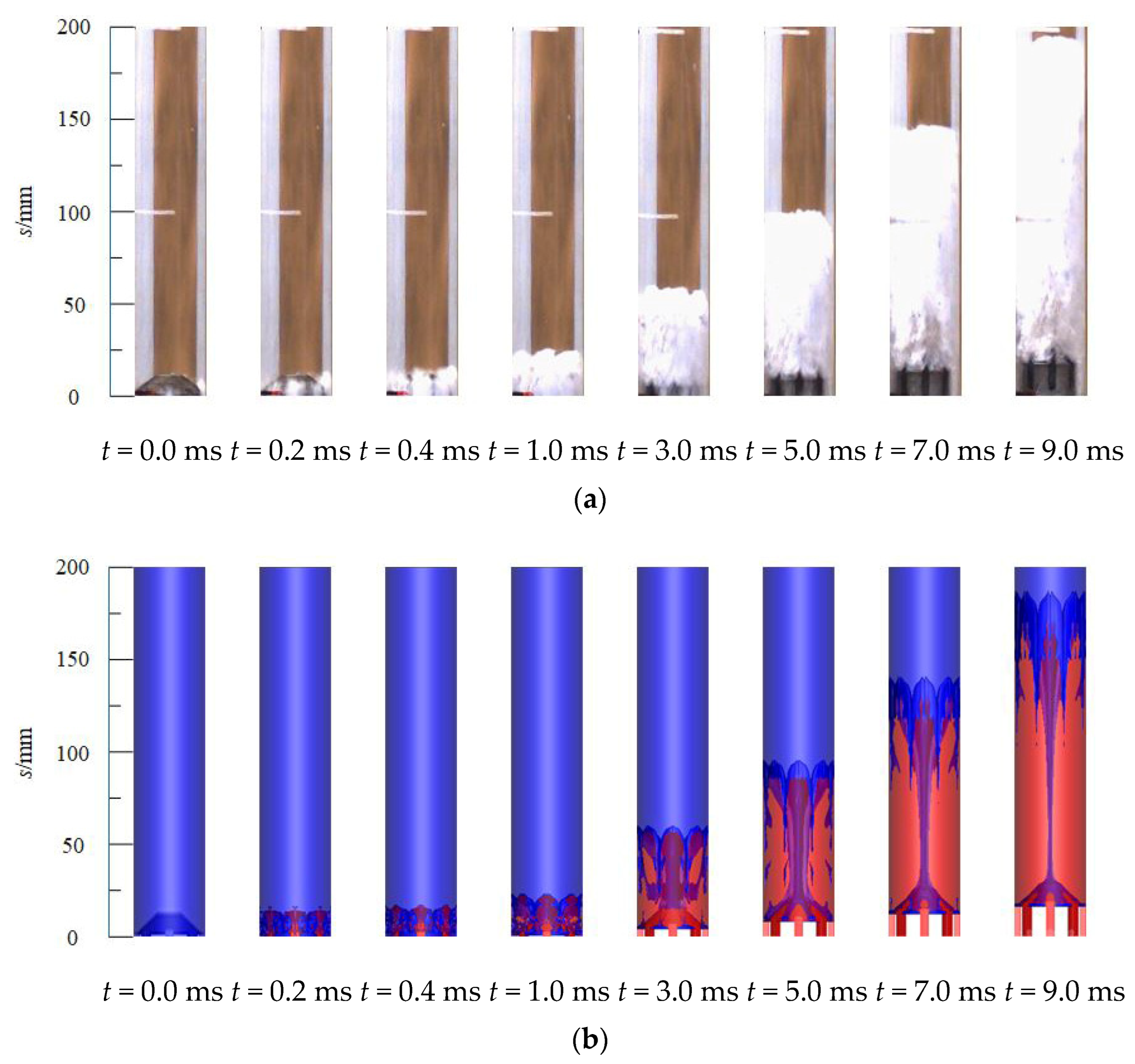
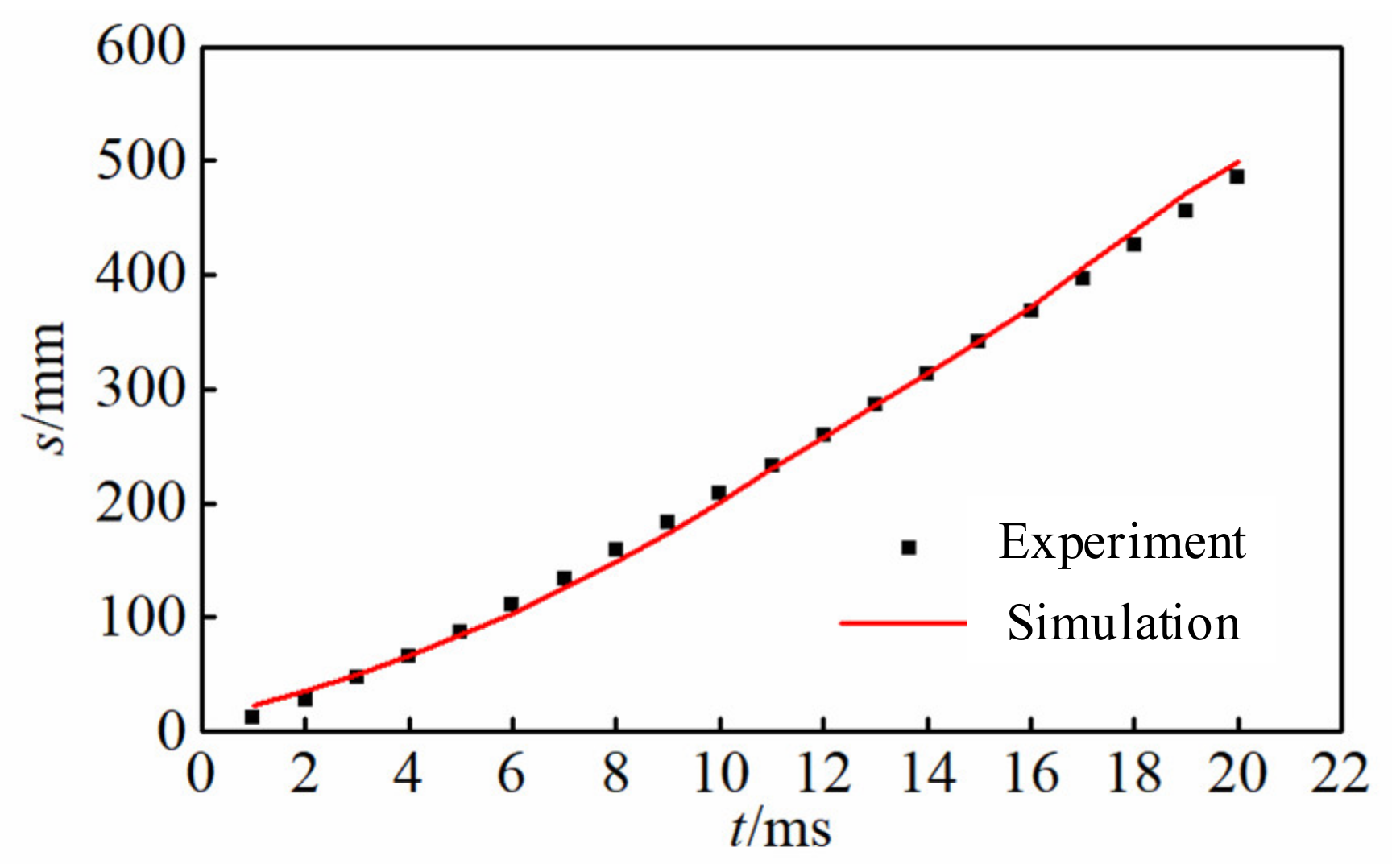

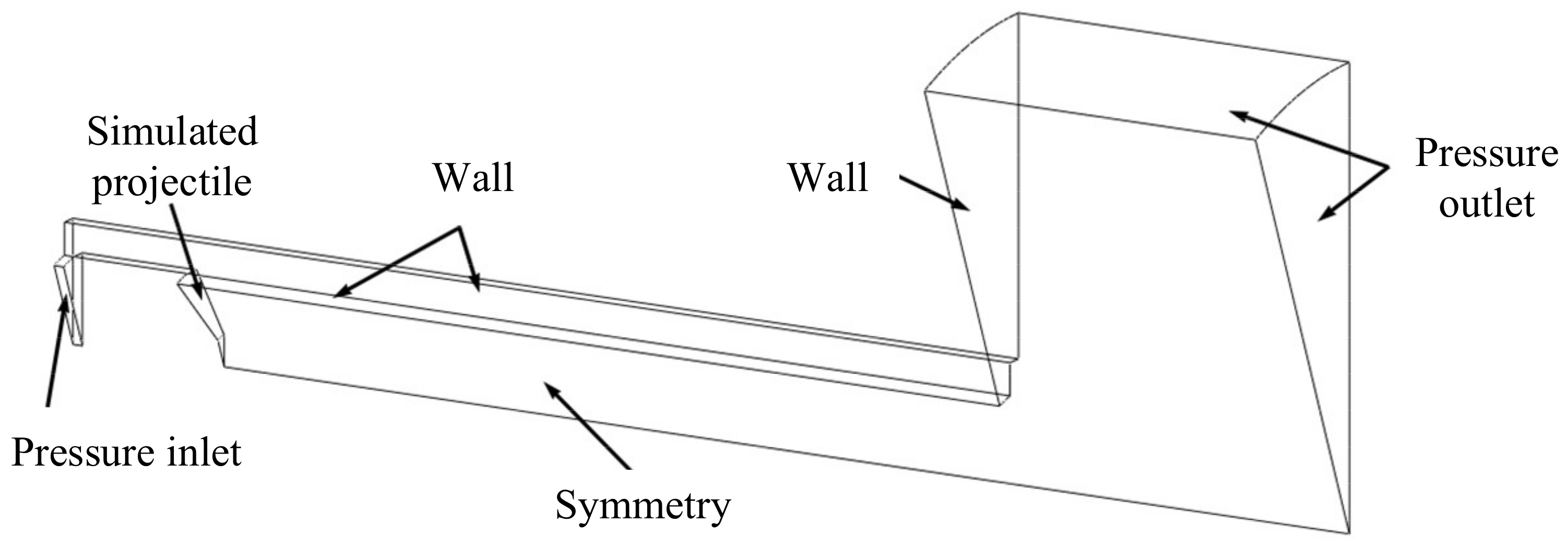
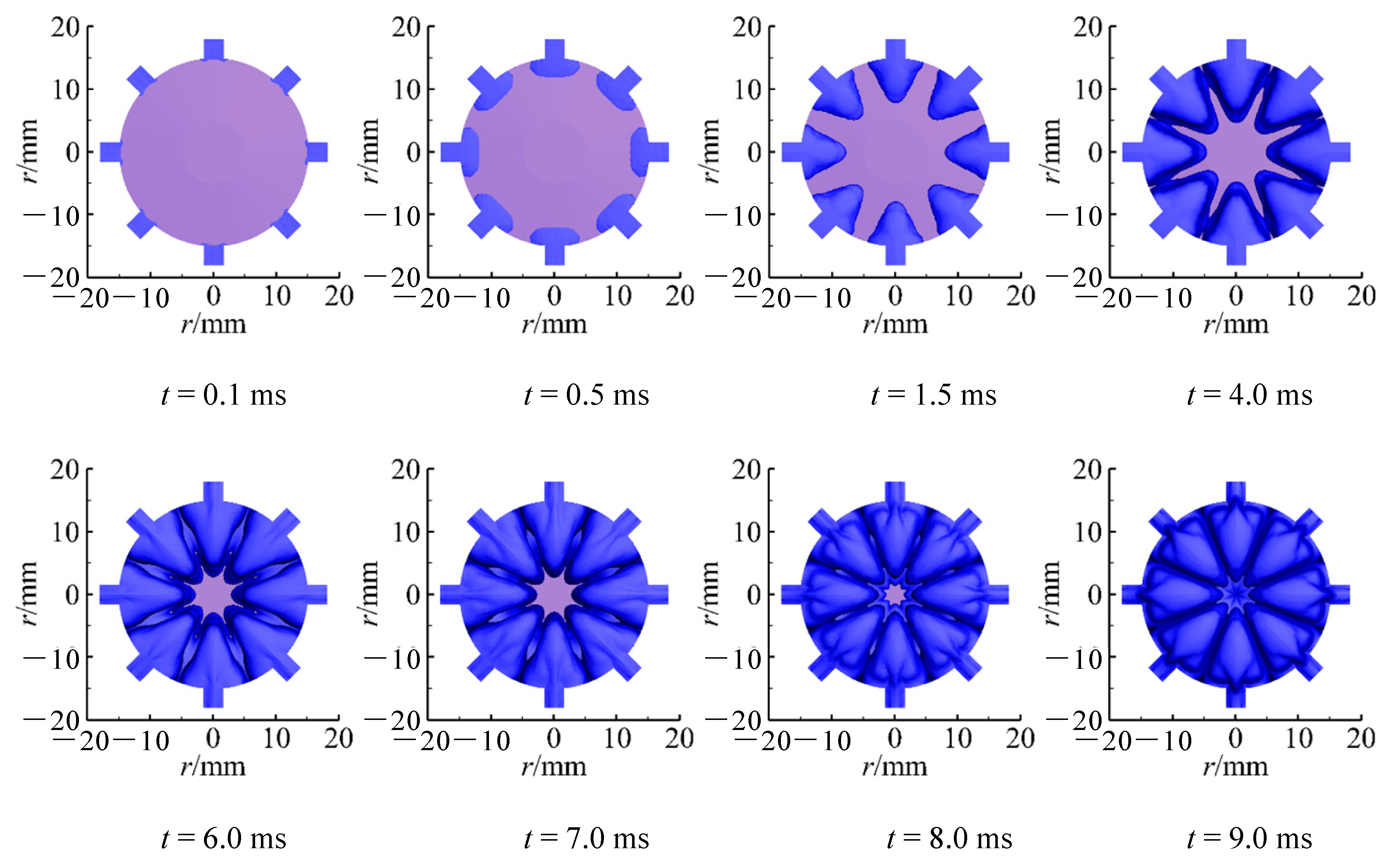
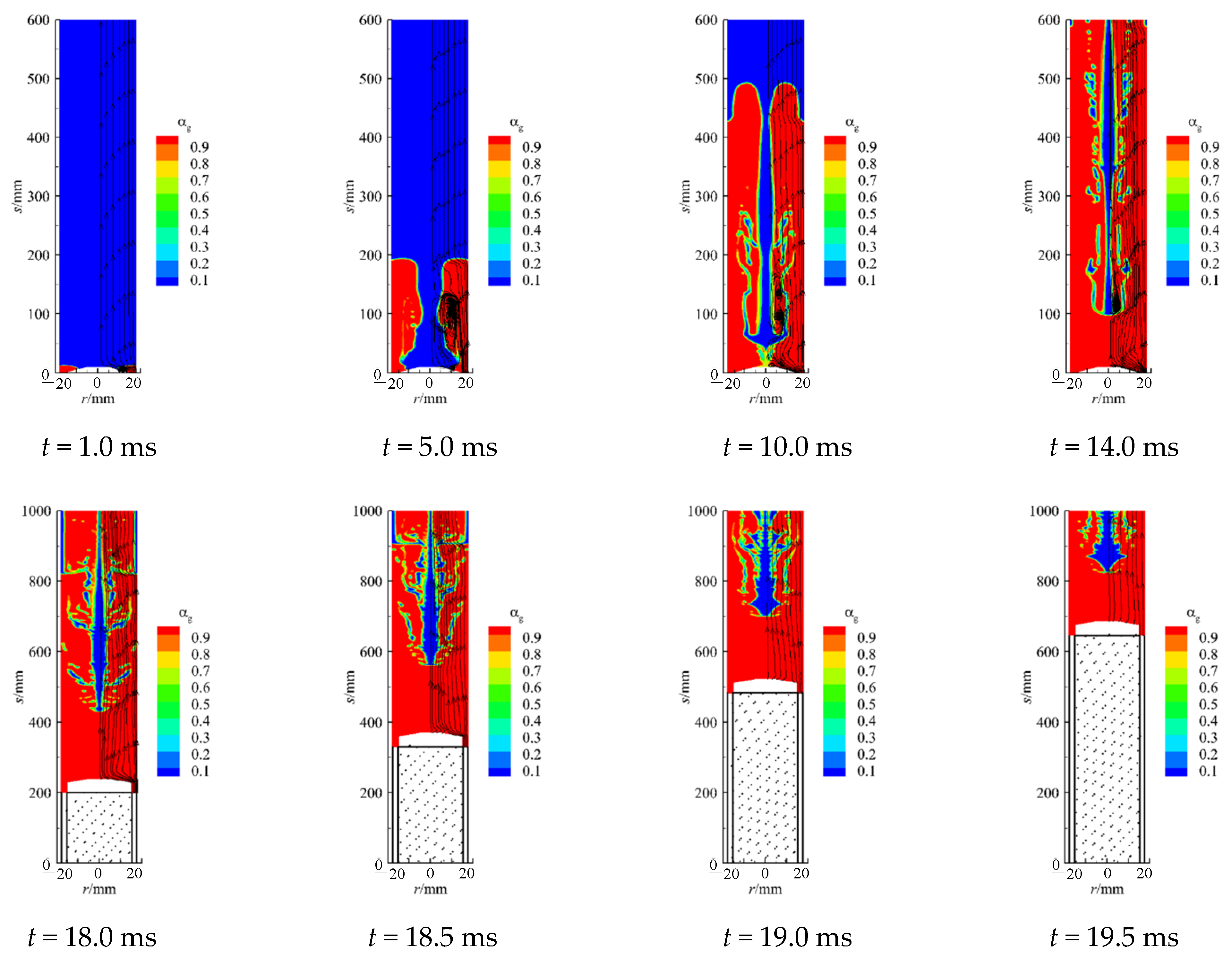
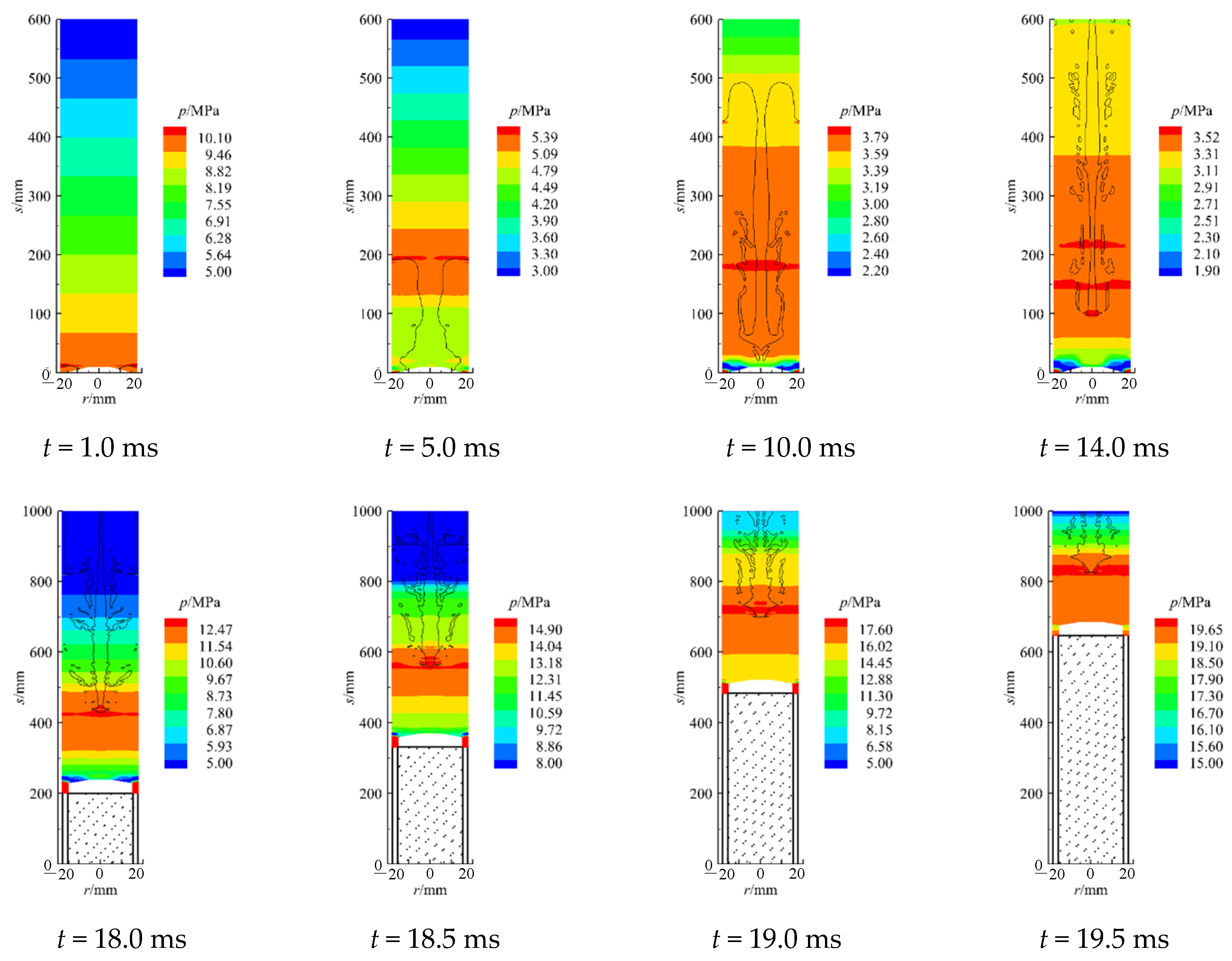
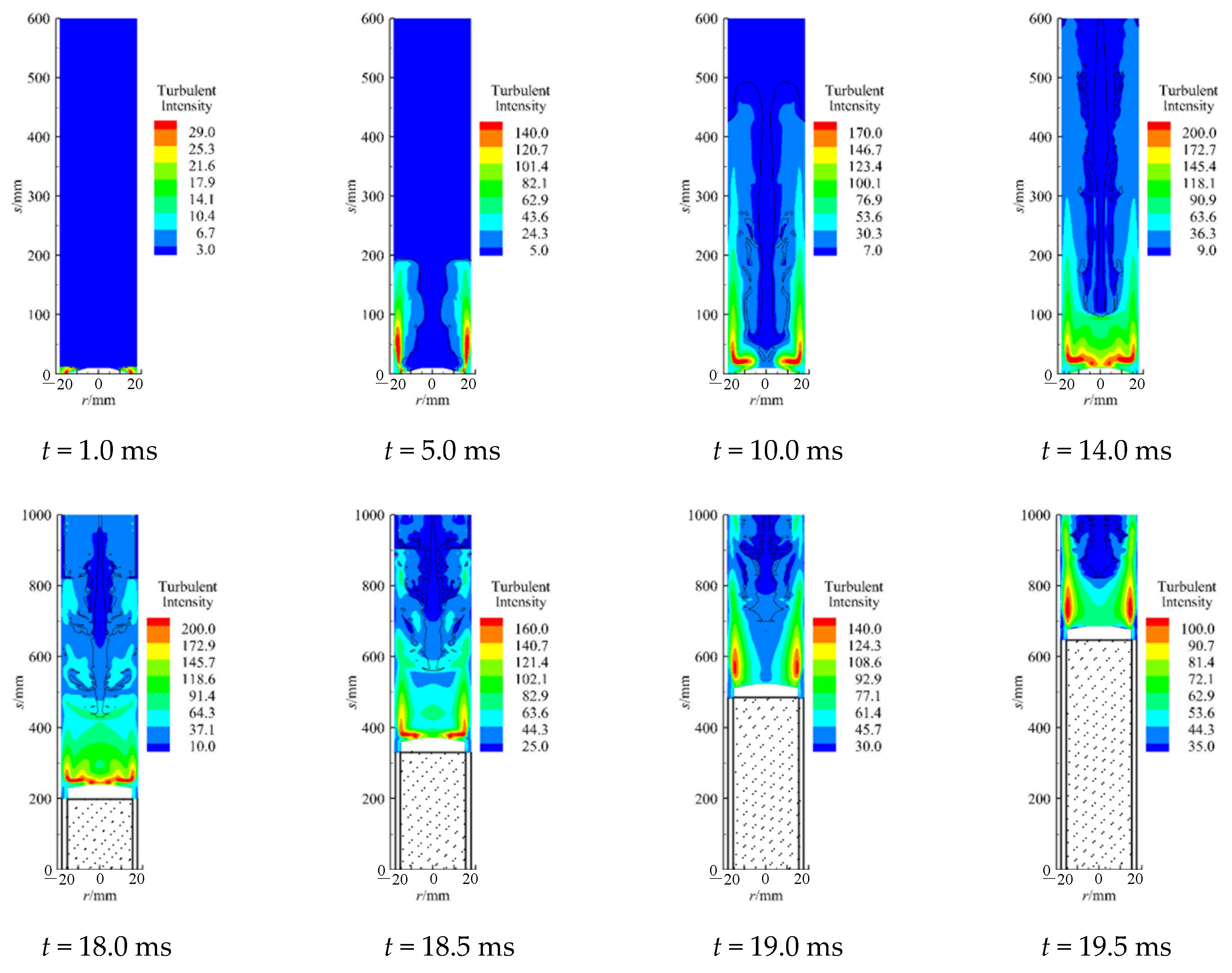
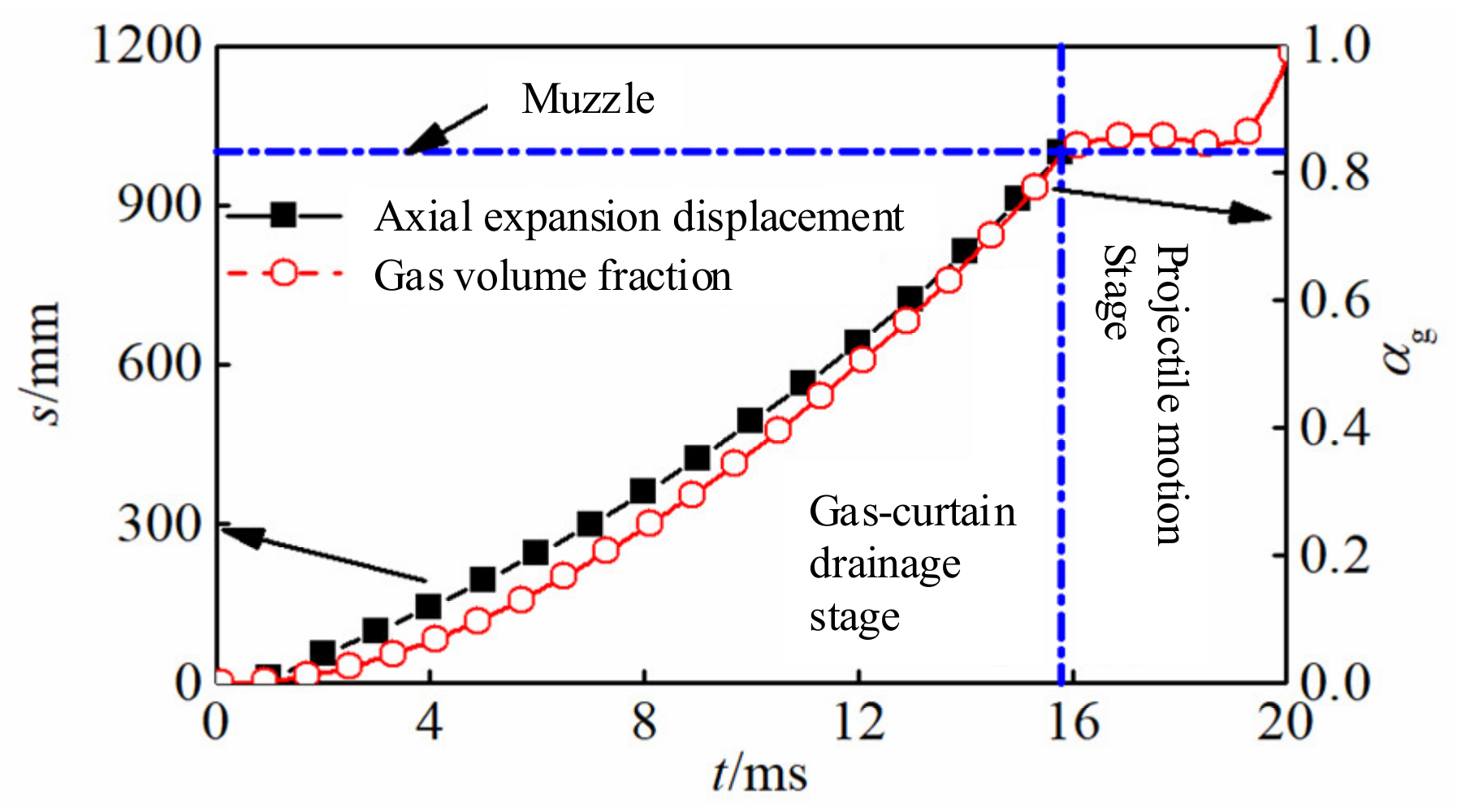
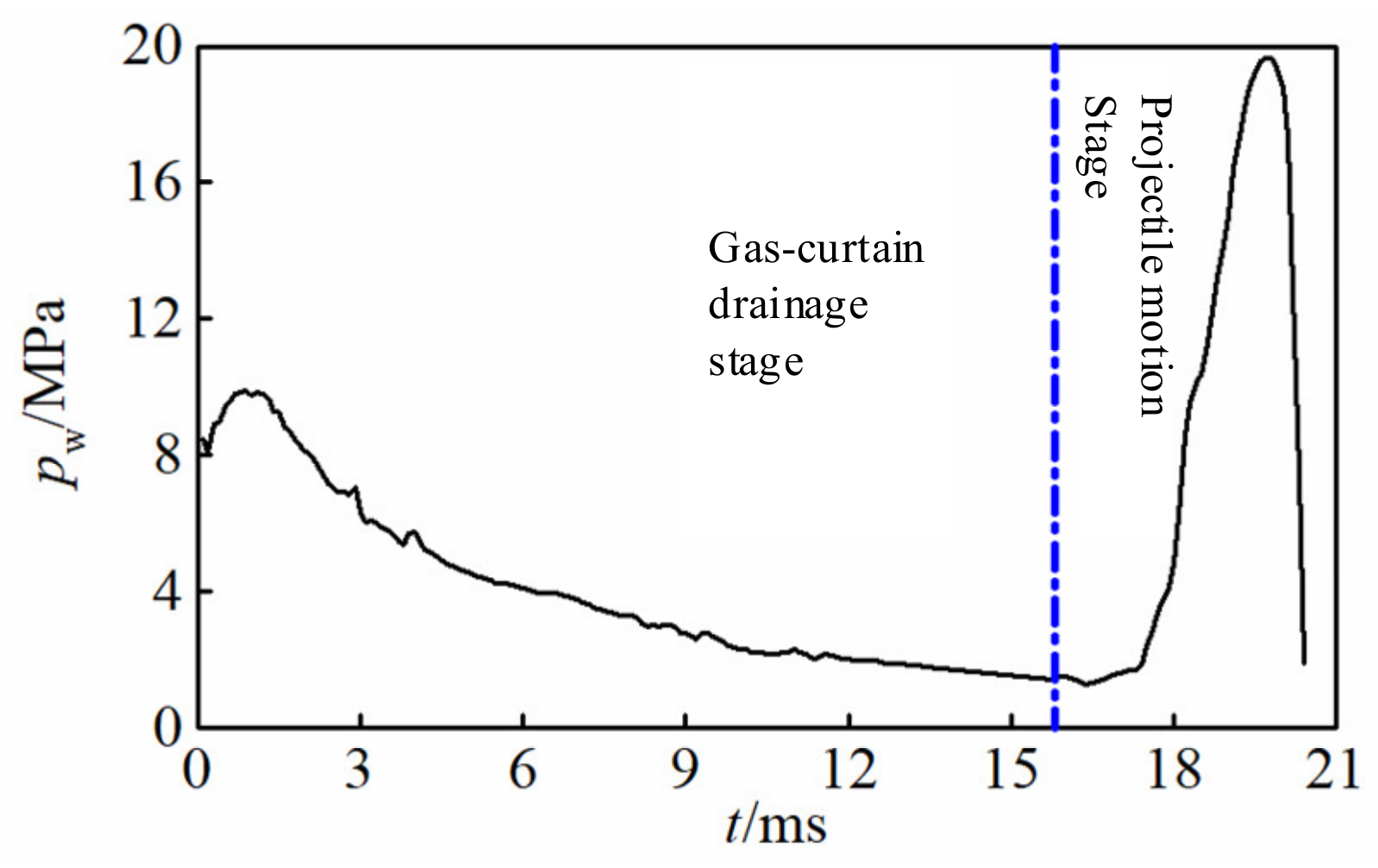
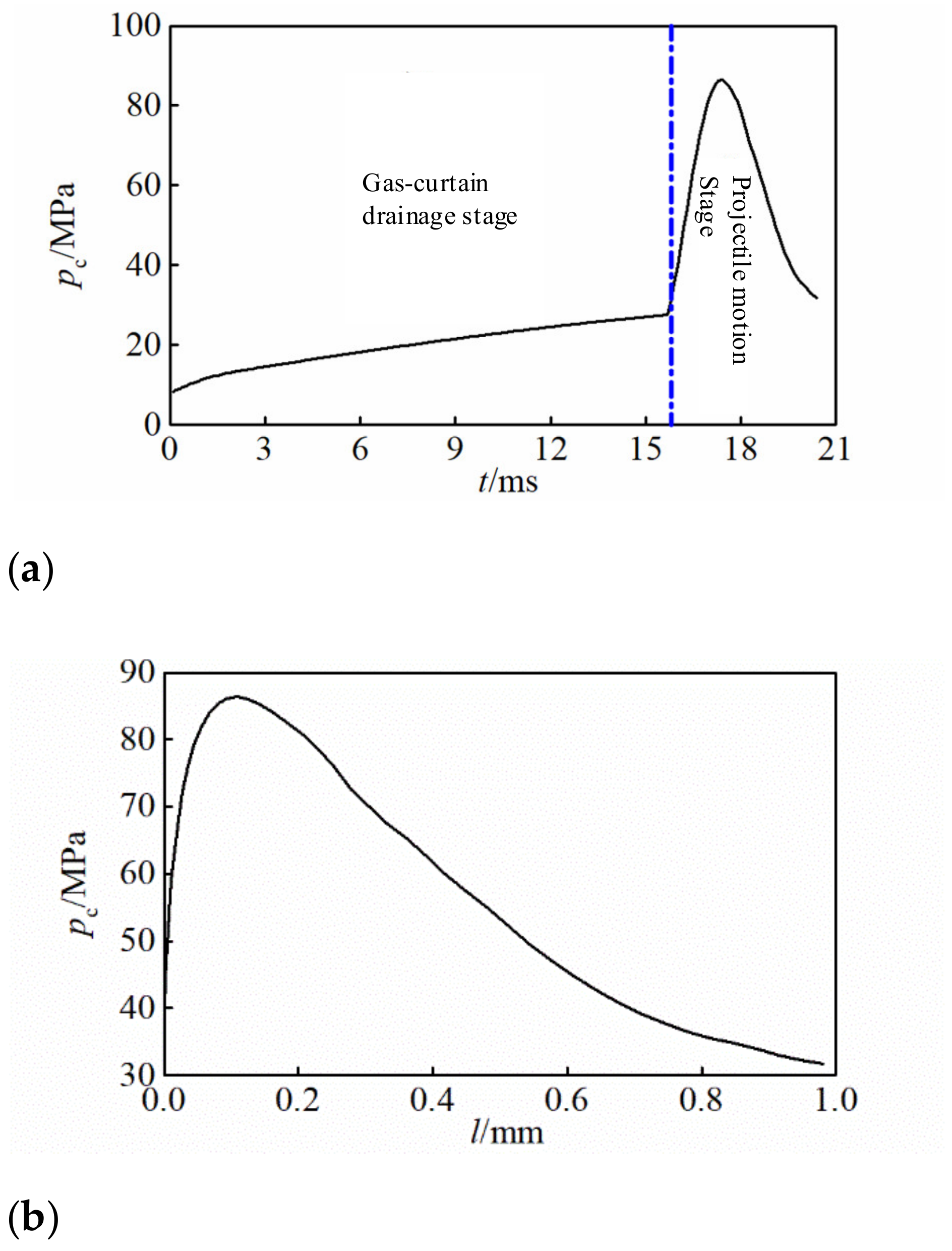
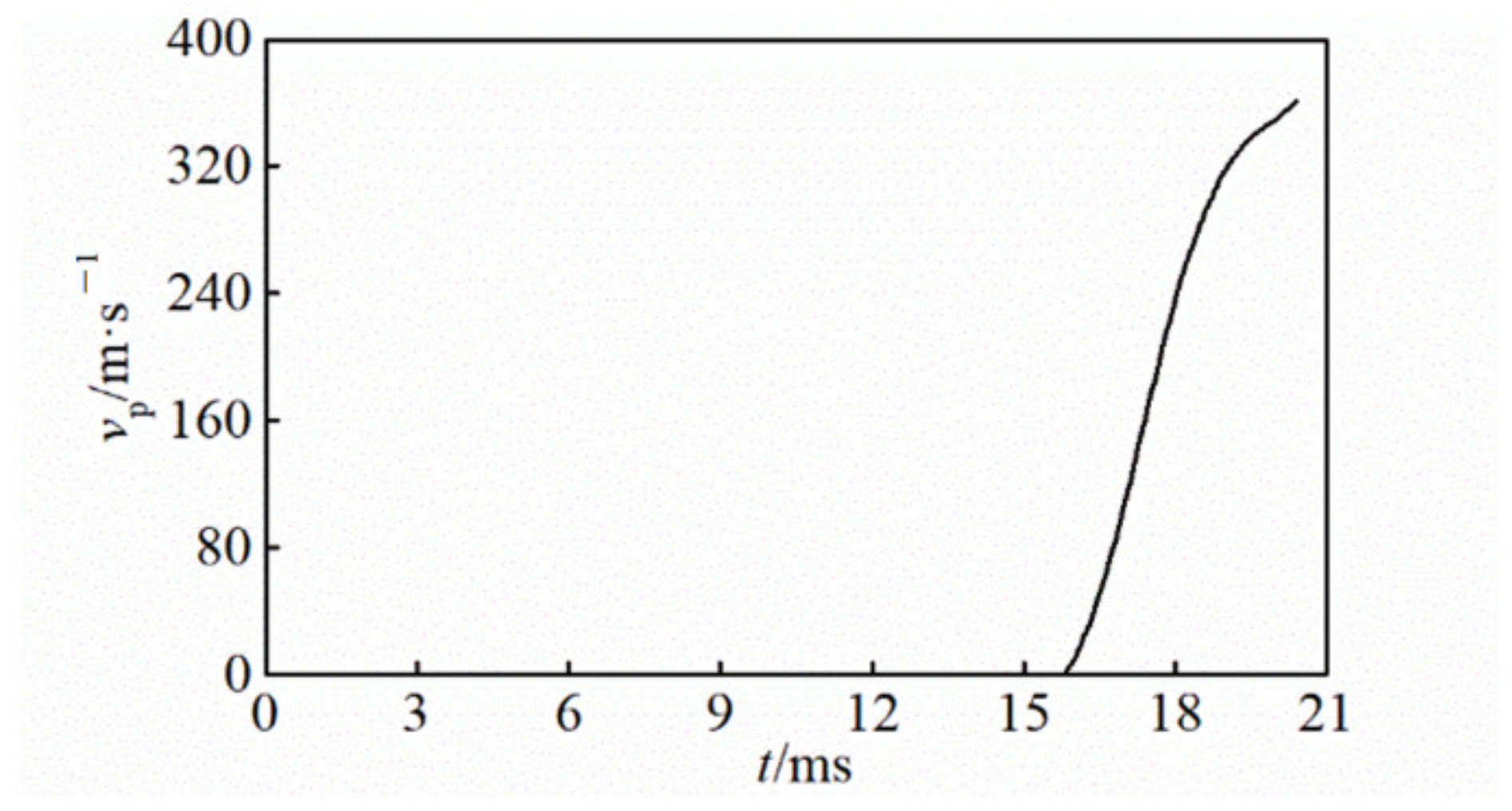
| Parameter | Value | Unit | Parameter | Value | Unit |
|---|---|---|---|---|---|
| hb | 0.125 | mm | 0.09 | kg | |
| 1.81 × 10−8 | m/(s·Pan) | 1.82 × 10−8 | m/(s·Pan) | ||
| 0.77 | / | 0.86 | / | ||
| 7.5 × 105 | kJ/kg | 9.5 × 105 | kJ/kg | ||
| 1650 | kg/m3 | 1650 | kg/m3 | ||
| 1.94 × 10−4 | m3 | m | 0.29 | kg | |
| P0 | 8.0 | MPa | Pj | 30.0 | MPa |
Disclaimer/Publisher’s Note: The statements, opinions and data contained in all publications are solely those of the individual author(s) and contributor(s) and not of MDPI and/or the editor(s). MDPI and/or the editor(s) disclaim responsibility for any injury to people or property resulting from any ideas, methods, instructions or products referred to in the content. |
© 2022 by the authors. Licensee MDPI, Basel, Switzerland. This article is an open access article distributed under the terms and conditions of the Creative Commons Attribution (CC BY) license (https://creativecommons.org/licenses/by/4.0/).
Share and Cite
Zhang, X.; Yu, Y.; Hu, Y. Study on Evolution Characteristics of Gas–Liquid Interaction in a New Gas-Curtain Launcher. J. Mar. Sci. Eng. 2023, 11, 55. https://doi.org/10.3390/jmse11010055
Zhang X, Yu Y, Hu Y. Study on Evolution Characteristics of Gas–Liquid Interaction in a New Gas-Curtain Launcher. Journal of Marine Science and Engineering. 2023; 11(1):55. https://doi.org/10.3390/jmse11010055
Chicago/Turabian StyleZhang, Xinwei, Yonggang Yu, and Yubo Hu. 2023. "Study on Evolution Characteristics of Gas–Liquid Interaction in a New Gas-Curtain Launcher" Journal of Marine Science and Engineering 11, no. 1: 55. https://doi.org/10.3390/jmse11010055
APA StyleZhang, X., Yu, Y., & Hu, Y. (2023). Study on Evolution Characteristics of Gas–Liquid Interaction in a New Gas-Curtain Launcher. Journal of Marine Science and Engineering, 11(1), 55. https://doi.org/10.3390/jmse11010055






